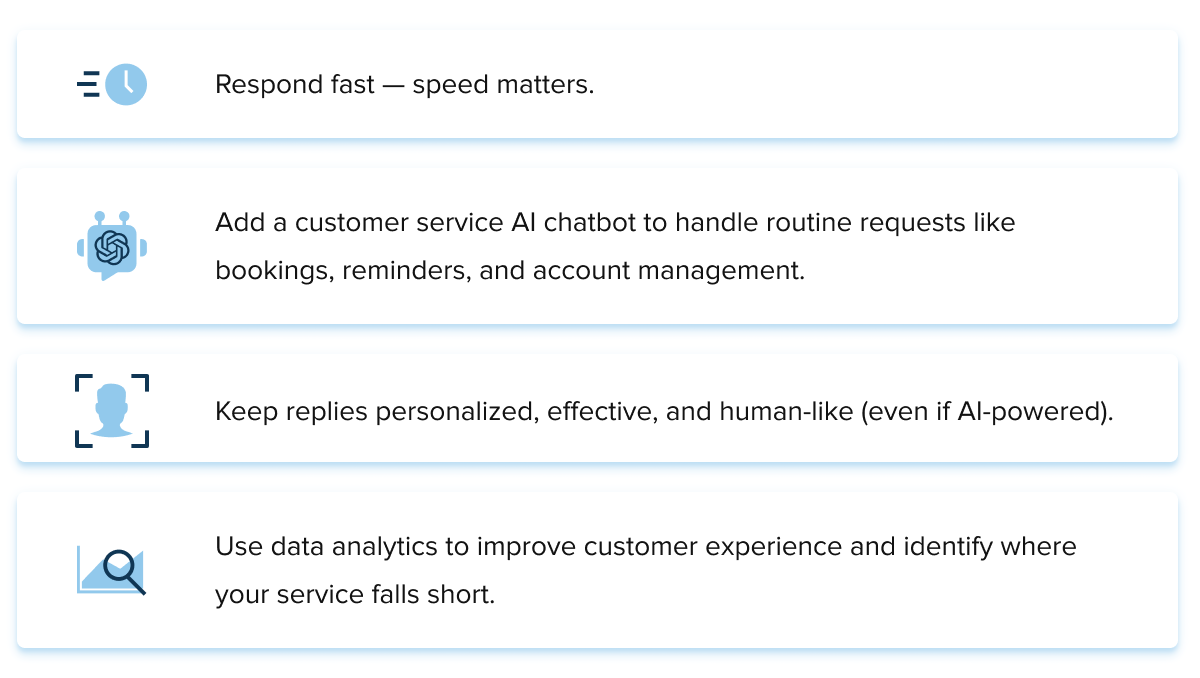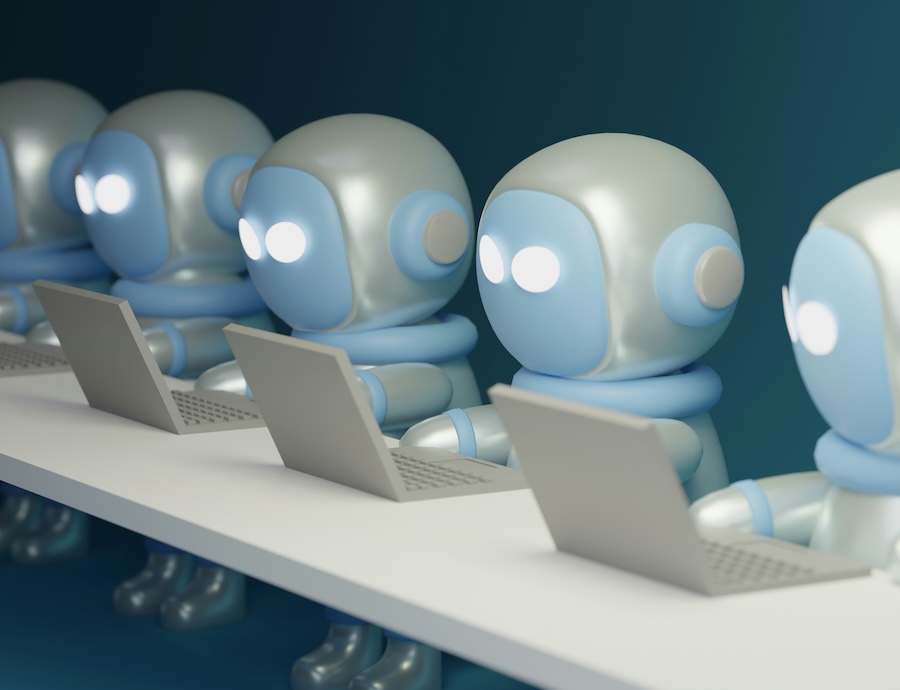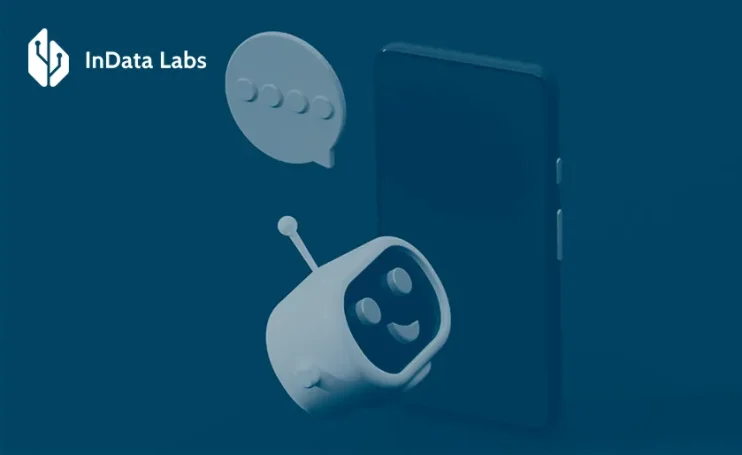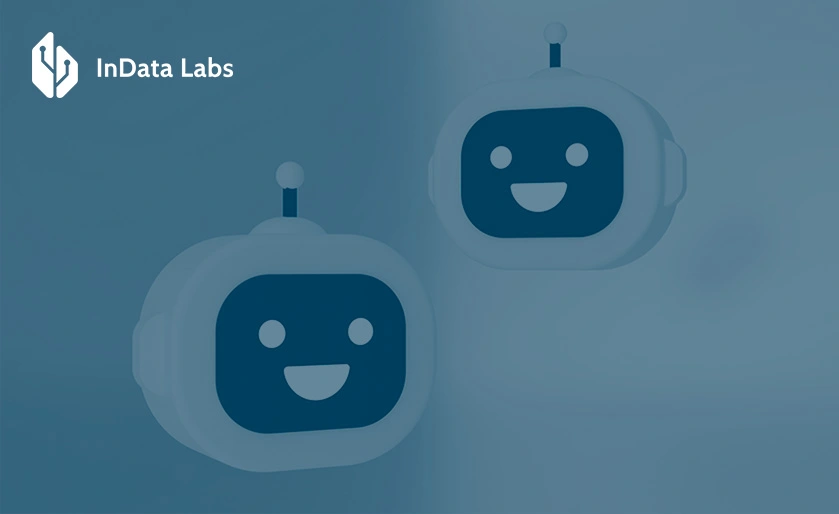How can chatbots improve customer service? Imagine a dialogue:
— Your request is in! Please expect a call from our manager.
— No, thanks. I’m not in the mood for a phone chat. I would prefer an AI chatbot for customer service, if possible.
Surprised? Welcome to 2025, where buyers prefer speed and don’t want sales calls. We research, compare, and click “buy” without the back-and-forth. Surprisingly, many businesses still haven’t caught up. Slow responses, limited support hours, and that “please hold” torture track? No wonder, as of 2024, 96% of consumers believe that more companies should implement chatbots for improving customer service — answer questions instantly, with 24/7 availability and zero hassle.
If you haven’t automated yet, you’re missing out on money. Read on to see why innovative businesses embrace best chatbot customer service — and how you can, too.

Source: Unsplash
Chatbot customer service stats: Why your customers would rather text than talk
Remember when sales reps could smooth-talk their way into a deal over the phone? Those days are gone. Today’s consumers are dodging emails, ignoring calls, and treating sales pitches like spam filters treat junk mail. And the numbers don’t lie: 78% of consumers want the option to text any business, and 74% say they’d buy from a company that lets them message instead of call.
It’s not just a phase — it is a full-blown trend. The Economist calls it the hermit consumer age, a shift that COVID kicked off and never stopped. People would rather deck out their home office than dine out, use a self-checkout than chat with a cashier, and text an AI chatbot over talking to a real person.
Why such a shift? We are more self-sufficient, more digital-first, and, let’s be honest — we are less patient. While texting is faster, easier, and less intrusive. You can fire off a message while doing other things. You can share links, photos, and documents when needed — something a call can’t do.
So, how do you keep up and not lose customers in this messaging-first world?

The brands that get this are winning. If your business still relies on phone calls and email blasts, it’s time to improve your customer experience strategy by using LLM development potential and giving your customers the seamless AI-powered experience they actually want.
Benefits of chatbots in customer service + customer service improvement strategies
Still wondering how can chatbots improve customer service? An AI customer service chatbot can positively impact customer communication and drive business growth. Let’s explore the key chatbot benefits for customer service and top strategies to improve customer service.
24/7 availability
In a global market, your customers could be anywhere — different time zones and schedules but one expectation: instant answers. Nobody wants to wait for a response that could make or break a buying decision. That is where chatbot use cases for customer service come in. A well-trained AI assistant can handle up to 80% of customer inquiries without human interaction.
But what about the tricky 20%? No problem. Intelligent chatbots don’t just give up. Got a human agent online? The chatbot queues the requests for them. Is no one available? The bot with the data scraping feature collects details, makes a gender analysis and identification, demographic and psychographic analysis, performs customer intent monitoring, and triggers a follow-up email. As a result, you get faster responses, happier customers, and zero missed opportunities. To learn more about other benefits of AI chatbots, please watch a video:
Multilingual support
Your customers aren’t just in one country or one time zone. They speak different languages, too. If your chatbot for customer service can’t keep up, you are losing potential sales before the conversation starts.

💡 Pro tip: improve customer experience by offering a language selection menu at the start of every interaction. Additionally, regularly update your AI-powered translation to adapt to colloquialisms, slang, and cultural nuances, ensuring responses feel natural across different regions.
Improved lead generation
AI-powered chatbots take lead generation to the next level. Instead of just collecting user details, they engage, qualify leads, and nurture potential customers in real-time, increasing conversions on an E-commerce platform or another source you use for sales. Unlike traditional forms, chatbots actively initiate conversations with visitors, increasing interaction rates. Instead of asking for a name and email, they dig deeper — “What’s your budget? What are you looking” for?”—so sales teams get high-quality leads.
Based on responses, AI bots can suggest relevant products/services or offer exclusive discounts, boosting conversions. Moreover, chatbots can send follow-ups, schedule demos, and even guide users through the sales funnel.
💡 Pro tip: improve your customer experience by using smart triggers to prompt ChatGPT customer service chatbot interactions based on a visitor’s behavior (e.g., browsing specific products for a certain amount of time) to increase lead generation chances. Set up automated follow-ups using chatbots to re-engage potential leads who didn’t convert immediately, offering them special promotions or relevant content.

Source: Unsplash
Omni-channel capabilities
Today’s customers aren’t just hanging out on your website. They are scrolling through social media, WhatsApp, Slack, and SMS or iMessage. You’re missing out if your business isn’t meeting them where they are.
That is where omni-channel AI-powered chatbots come in. These bots integrate across multiple platforms, ensuring customers get the same seamless experience whether they are chatting on your website, DM-ing your brand on Instagram, messaging via WhatsApp or Facebook Messenger, or engaging through email.
Customers can start a chat on one platform and pick it up on another without repeating themselves. Studies show that businesses with omnichannel strategies retain 89% of customers, compared to just 33% for those without.
Better personalization
It’s delightful when the barista at your local coffee shop greets you by name and asks, “How are you doing?” Similarly, it’s satisfying when Netflix accurately suggests a series for your weekend or when Google Ads presents a discount on the sneakers you were eyeing yesterday. These personalized experiences make us feel valued and understood.
Nowadays, customers expect more than just quick replies. They want conversations that feel personal, relevant, and intuitive. According to a McKinsey study, 71% of consumers expect companies to deliver personalized interactions, and 76% get frustrated when this doesn’t happen. And according to Gitnux’s MARKETDATA-2024 report, 91% of consumers are more inclined to make a purchase from brands that serve up tailored offers.
That is one of the advantages of chatbots in customer service. AI-powered chatbots deliver precisely that by leveraging data and machine learning to customize interactions in real time, ultimately improving customer experience and boosting satisfaction. Chatbots recall previous chats, preferences, and purchases. Based on browsing history and responses, AI bots offer tailored suggestions, just like Netflix or Amazon. Last but not least, chatbots can automatically switch languages and cater to cultural preferences, ensuring a seamless experience for global customers.
Efficient upselling & cross-selling
Love it or hate it, companies have always been pros at getting you to spend just a little more. They know exactly when to strike — right when you are in buying mode. Because, let’s be honest — if a person is already spending $100, what’s another $10 for a premium version, faster shipping, or a bundle deal?
AI chatbot development is the new sales reps in this game, but these solutions don’t need a script. They use customer data, past behavior, and real-time interactions to nudge a customer toward that extra purchase seamlessly and strategically. Instead of generic pitches, chatbots tailor upsell offers based on real-time user activity. If a customer is browsing laptops, the bot might suggest a high-performance model or accessories like a wireless mouse or extended warranty.
💡 Pro tip: improve the customer experience by using “just in time” upselling. If the AI chatbot sees a user is close to finalizing a purchase, it can suggest complementary items that would enhance their experience. This strategy reduces the risk of overwhelming the customer earlier in their journey.
Smart insights to drive growth and innovation
In the world of digital marketing, data is king — and AI-powered chatbots are your personal data detectives. These bots track consumer behavior, analyze purchasing patterns, and provide actionable insights that can help your business optimize marketing strategies and expand reach.
Chatbots gather valuable insights into preferences, pain points, and buying habits by monitoring interactions. This information allows businesses to tailor marketing efforts to specific customer segments, boosting relevance and engagement.
Additionally, simple chatbot interactions can prompt customers to provide feedback on their experience or customer satisfaction with a product. This instant feedback can be analyzed and used to improve products, tweak services, or optimize website functionality for a smoother user experience.
💡 Pro tip: use customer service chatbot to run micro-surveys after everyday actions, like completing a purchase or browsing a particular product.
How can a chatbot improve customer service:
When to automate & when it is not a fit
Chatbots are game-changers when it comes to streamlining operations and taking your customer service to the next level. They enhance customer experience with AI. However, they are not one-size-fits-all. Some tasks are better left to human hands, while others are a perfect match for automation.
When to use chatbots:
- Handling high-volume, repetitive tasks. Automation is all about tackling consistent, repetitive tasks. Best customer service chatbots excel at this, managing the same inquiries and requests time after time, such as order tracking, FAQs, or basic customer support. If you have a clearly defined, repeatable process, automation saves time and boosts efficiency. For example, an AI chatbot for customer service can easily handle simple tasks like resetting passwords or providing product recommendations — tasks that don’t change frequently.
- Enhancing customer engagement. Chatbots can keep the conversation going without ever taking a coffee break. They can greet customers, recommend products, and guide users through a purchase customer journey instantly. When you need to keep customers engaged but don’t want to drain your resources with constant live support, chatbots are a great choice.
- Low-stakes transactions. Tasks that do not require emotional intelligence or high-level decision-making are perfect for bots. Order confirmations, subscription renewals, or straightforward purchases can all be automated effectively, ensuring customers don’t have to wait.
When chatbots aren’t the best fit:
❌ Complex customer support. If a task requires empathy, nuance, or deep problem-solving, chatbots are not the best option. Intricate tech support or sensitive issues still require the human touch to resolve properly.
❌ Highly personalized sales conversations. While AI-powered bots can upsell and recommend products, high-stakes sales often need human interaction. For instance, if you’re dealing with complex solutions or premium services, a sales expert can provide a personalized experience and build trust that even the best chatbots for customer service can’t usually replicate.
❌ Startup flexibility. For startups, especially those in the early stages or experiencing rapid change, automating processes like technical support is often impractical.
Since processes may shift weekly or the business may pivot frequently, it is difficult to set up consistent automation when everything is in flux. At this stage, you’re likely still testing and adjusting, which means automation is not yet beneficial. However, once you establish stable processes that are consistent, automation becomes essential to scale and optimize.
Best AI chatbot for customer service:
When do chatbots for customer support fail?
Without careful implementation, chatbots can become a source of frustration for customers and a headache for businesses. Understanding these pitfalls can help companies to avoid common traps and leverage chatbots effectively.
Lack of context-awareness
Many chatbots fail to understand the full context of a conversation. They may give irrelevant responses, make assumptions, or miss previous interactions with the customer. Even AI-powered systems can struggle with continuity, especially in long-term relationships. At the same time, chatbots that can’t remember previous interactions often give robotic, detached answers that frustrate customers who feel like they are starting from scratch each time.
💡 Pro tip: to improve customer service, leverage customer relationship management (CRM) tools to feed data to the AI chatbot in real-time, ensuring that it remembers past issues, preferences, or ongoing conversations. Use Generative AI development and solutions to create more personalized interactions by referencing previous support queries or purchases.
Not providing clear exit routes
When customers hit a dead-end with a chatbot, they often get stuck. Bots that fail to recognize when a conversation should be handed over to a human agent create frustration and force customers to go through endless loops of irrelevant questions.
💡 Pro tip: build escalation paths for customer service chatbot early in the conversation for customer service improvement. If a bot cannot resolve an issue after a set number of interactions or a customer shows frustration (through tone analysis or keyword detection), it should automatically offer the option to speak to a human agent or provide a callback option.
Too much reliance on keyword matching
Many chatbots rely heavily on keyword matching to provide responses. This leads to reactions that may seem robotic or irrelevant, mainly when customers use synonyms or ask in a less direct manner.
💡 Pro tip: invest in more advanced AI models that leverage natural language processing (NLP) to understand customer intent, not just keywords. Additionally, ensure that the bot can handle variations in phrasing and ask clarifying questions when it’s unsure.
Ignoring feedback loops
Chatbots in customer service often operates in isolation, with minimal feedback mechanisms. However, without continuous learning, these solutions can become outdated, unable to adapt to new customer queries, products, or issues.
💡 Pro tip: implementing a chatbot, incorporate also a robust feedback loop where customers can easily rate their chatbot interactions. Use additional customer feedback analytics solutions to improve the AI, refine responses, and address gaps in its knowledge. Regularly update and retrain your chatbot based on customer feedback and new business needs.
Choosing a chatbot without thinking ahead
The chatbot for customer service you choose today should align with your future growth. At the same time, many businesses rush into buying the first solution they come across, only to realize later that their AI chatbot for customer service lacks essential features, does not scale, or doesn’t integrate well with their tech stack.
💡 Pro tip: always think a few steps ahead. What will your customer support operation look like in a year or two? Will you need AI-driven automation? Deeper analytics? Multichannel support? Focus on solutions that offer modular features or integrations that align with your long-term strategy. Investing in a slightly more advanced tool now can save you from costly migrations later.

Source: Unsplash
Best AI chatbot customer service examples from leading companies
AI-powered chatbots are transforming customer support by providing instant responses, handling inquiries efficiently, and improving customer experience. Here are some customer service chatbot examples used by leading brands:
- Sephora Virtual Artist. This chatbot, available on Messenger, helps users find beauty products, try virtual makeup using AR, and get personalized recommendations based on their preferences.
- H&M Chatbot. The fashion brand’s chatbot, available on Kik, assists shoppers with outfit suggestions based on their style preferences, helps find products, and provides order tracking.
- Bank of America’s Erica. A virtual financial assistant provides account updates, helps with transactions, and offers financial advice through the bank’s app. Erica has handled millions of customer interactions, improving customer service and efficiency.
- Nike StyleBot. Available on Messenger, this chatbot offers personalized style recommendations, assists with product searches, and engages users with interactive content.
- KLM’s BlueBot (BB). The airline’s chatbot assists travelers with booking tickets, flight updates, and check-in processes via Messenger, WhatsApp, and Google Assistant. It has significantly reduced response times and improved customer service.

Chatbots and customer service: Are chatbots replacing human customer service?
There are cases where businesses are eliminating traditional support departments, opting to replace them entirely with the use of ChatGPT, GPT integration services, or any AI-driven systems. On the surface, this might feel like the beginning of a dystopian future. But can AI, chatbots, or automation really take the place of people in the AI customer service era?
Not completely. But they can elevate it, making service faster, more personalized, and more efficient. Instead of replacing customer service with bots, the real win lies in collaborating with them. Use the best customer service chatbot to handle routine inquiries and free up your human agents to focus on higher-value interactions.
Chatbots for improved customer experience can serve as the first line of defense, gathering information, solving fundamental problems, and escalating more complex issues to human agents who are equipped to handle them.
Therefore, the real question isn’t whether bots will replace humans but how we can leverage them to make customer service more innovative, effective, and more human than ever before.
Improving customer experience: Human-AI balance
So, how can companies strike the perfect balance between the speed and efficiency of chatbots and the empathy and emotional intelligence of human agents? We’ve put together non-obvious, actionable tips on how to improve customer experience:
#1. Create seamless transitions between chatbot and human agents
A seamless handoff between chatbots in customer service and humans is key to creating a positive customer experience. When a chatbot reaches its limit, it should smoothly transfer the customer to a human agent without causing frustration or delay. Customers should never feel like they’re starting from scratch with a human agent after speaking to a bot.
#2. Empower chatbots with personalization data
Leverage customer data from CRM systems to personalize chatbot interactions even before a customer reaches an agent.
For example, bots can reference a customer’s previous purchases, interactions, or support tickets, creating a personalized experience that feels less robotic and more relevant. This allows human agents to jump into a conversation tailored to the customer’s history, reducing the time spent catching up and enhancing the overall experience.

Source: Unsplash
#3. Implement ‘AI co-pilots’ for human agents
While human agents are handling complex issues, integrate AI-powered co-pilots in the background to assist them in real-time.
These AI systems can pull up relevant customer history, suggest possible solutions based on prior interactions, and even highlight common trends in customer complaints. This allows human agents to focus on the emotional aspects of the interaction, while the bot handles the heavy lifting of research and data retrieval.
#4. Incorporate AI-driven sentiment analysis
Integrate sentiment analysis tools into your chatbot’s capabilities for customer experience improvement. By analyzing the tone and sentiment of a customer’s message, the bot can decide whether to escalate the conversation to a human agent.
For example, if the customer’s message is highly negative or frustrating, the bot can immediately pass it to a human to defuse the situation with empathy. This reduces the risk of escalating anger or dissatisfaction and ensures customers are always treated respectfully.
#5. Provide an AI-backed knowledge base for human agents
Chatbots for customer service can build a knowledge base by pulling from the most frequently asked questions and creating a resource that human agents can use during conversations. This AI-backed knowledge can help agents access relevant information quickly, ensuring they can provide fast, accurate, and consistent answers. It also allows agents to stay on top of any new products, services, or changes without feeling overwhelmed by having to memorize everything.
#6. Set clear expectations for customers
Transparency is key to managing expectations. If customers know they are speaking with a chatbot initially but can quickly escalate to a human when needed, they are less likely to feel frustrated or misled. Setting this tone from the beginning helps build trust with your customers.

Source: Unsplash
Lastly, do not forget to train your human agents. Just because you are automating part of the process doesn’t mean you should neglect human training. In fact, your human agents need to be even more skilled in areas like active listening, emotional intelligence, and conflict resolution. While AI chatbots for customer service can handle the basics, human agents must be prepared to handle sensitive or complex cases requiring more than quick answers.
Investing in ongoing training ensures that your customer support team can handle any situation with grace and empathy. This balance makes your support system more resilient and adaptable to various customer needs.

Additionally, chatbots can improve customer interactions by offering 24/7 support, personalized recommendations, and seamless integration with CRM systems. This not only enhances operational efficiency but also strengthens brand loyalty.
For businesses focused on improving the customer experience, adopting AI-powered chatbots can lead to better engagement, higher retention rates, and increased customer satisfaction. By continuously refining chatbot interactions based on user feedback and data analytics, companies can ensure a superior customer support strategy that aligns with evolving expectations.



